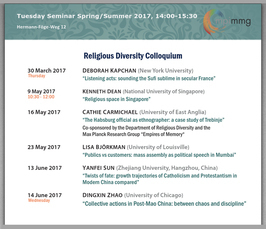"The Habsburg official as ethnographer: a case study of Trebinje"
Religious Diversity Colloquium Spring/Summer 2017
- Date: May 16, 2017
- Time: 02:00 PM - 03:30 PM (Local Time Germany)
- Speaker: Cathie Carmichael (University of East Anglia)
- Cathie Carmichael is Professor of European History at the University of East Anglia in Norwich, where she is Head of the School of History. She studied at the London School of Economics and the University of Ljubljana before completing a Ph.D at Bradford University. She has supervised over a dozen PhDs on the Balkans and Eastern Mediterranean and established a number of courses at BA and MA level. Her books include Slovenia and the Slovenes (co-authored with James Gow) (2000), Language and Nationalism in Europe (co-edited with Stephen Barbour) (2000), Genocide before the Holocaust (2009) and most recently Bosnia e Erzegovina. Alba e tramonto del secolo breve (2016). She is an editor of the Journal of Genocide Research.
- Location: MPI-MMG, Hermann-Föge-Weg 12, Göttingen
- Room: Conference Room

For more details please contact vdvoffice(at)mmg.mpg.de.
Between their arrival in the town in September 1878 to their hasty departure just over forty years later, the Habsburg authorities made a distinctive mark on the town in Hercegovina which was sometimes known as ‚Turkish Trebinje‘ because of its large Muslim population. A sturdy modern garrison was built on the edge of the old Ottoman town and multilingual regiments from all over the realm were stationed there and the garrison was duly equipped with state of the art military equipment. Their numbers swelled to about 3,000 after the annexation of Bosnia and Hercegovina by the Dual Monarchy in 1908. The soldiers and other staff brought their taste in regional food, musical instruments and literature with them. Officials undertook scientific expeditions and charted the Karst geomorphology. The essayist and medic Alois Pick served the regiment there and used his time to study local diseases including the endemic sandfly fever which he successfully identified for the first time. During these years, Trebinje became a bustling, lively town, attractive to tourists from Dubrovnik and was connected with other neighbouring towns through improvement in roads and the arrival of the railway in 1901. New businesses opened to serve the soldiers including booksellers and cafes. Many of the officials left written impressions of the town, its people and their customs. The cultural vestiges of the Ottoman era were particularly interesting to them, but they also recorded the deteriorating relations between the state and its Orthodox population. The Prague photographer Zikmund Reach captured the terrible mood of the summer of 1914, while others such as the young Viennese architect Richard Neutra recorded the life of a soldier during the First World War.